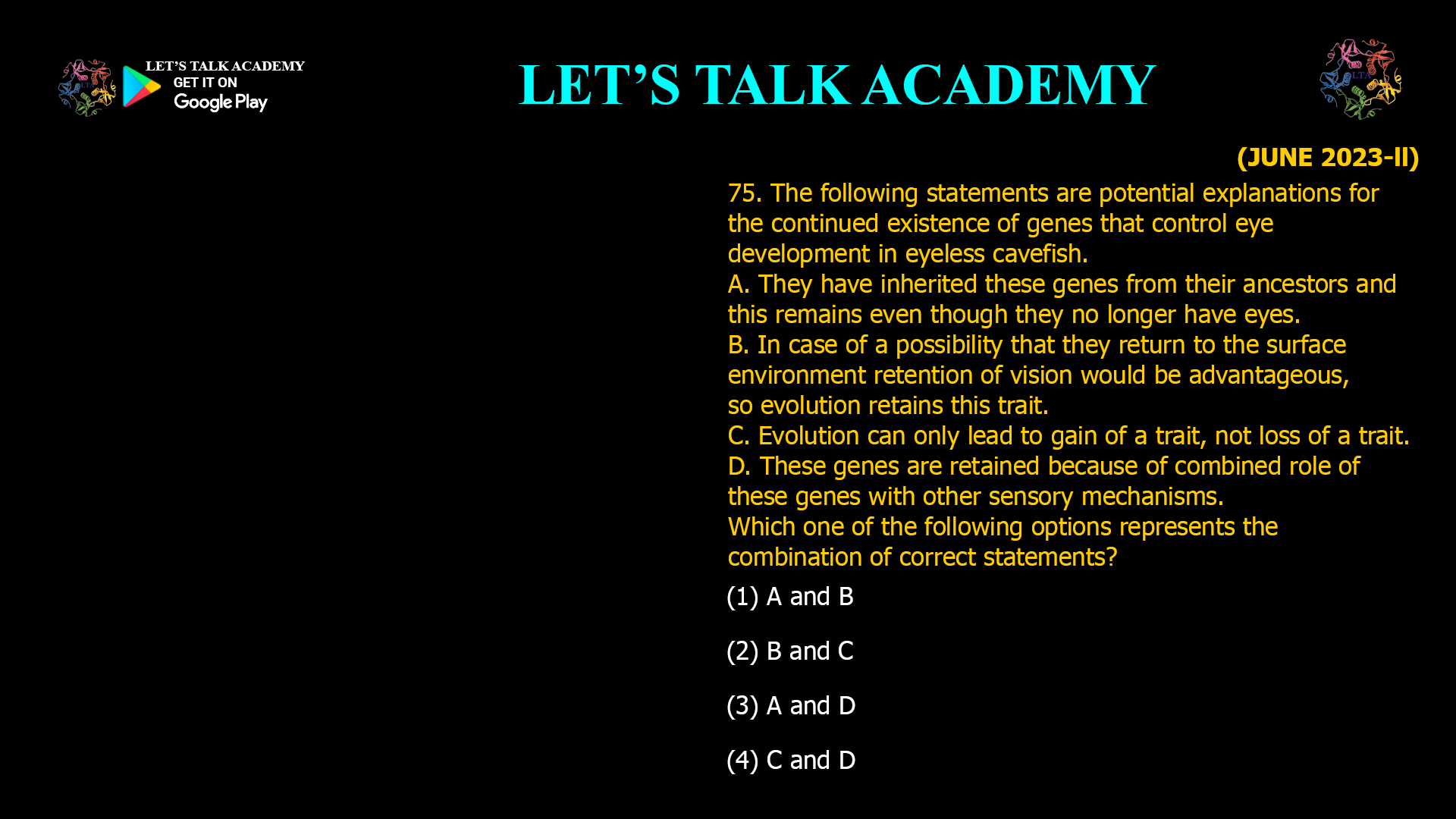- The following statements are potential explanations for the continued existence of genes that control eye development in eyeless cavefish.
A. They have inherited these genes from their ancestors and this remains even though they no longer have eyes.
B. In case of a possibility that they return to the surface environment retention of vision would be advantageous, so evolution retains this trait.
C. Evolution can only lead to gain of a trait, not loss of a trait.
D. These genes are retained because of combined role of these genes with other sensory mechanisms.
Which one of the following options represents the combination of correct statements?
(1) A and B (2) B and C
(3) A and D (4) C and DThe Genetic Legacy of Eye Development in Cavefish
Cavefish such as Astyanax mexicanus are famous for their regressed eyes. While adult cavefish lack functional eyes, embryos initially begin to develop eye structures, which later degenerate due to programmed cell death and altered gene expression. Despite this, the genes responsible for eye development—such as Pax6 and rx3—are present and, in some cases, even partially expressed in cavefish genomes. This observation leads to the question: Why do cavefish retain these genes?
Evaluating the Explanations
Let’s assess the provided statements in light of current scientific understanding and genetic evidence.
A. Inheritance from Ancestors
Statement: They have inherited these genes from their ancestors and this remains even though they no longer have eyes.
Analysis:
This is well-supported by genetic studies. Cavefish populations descended from surface-dwelling fish that had fully functional eyes. The genes for eye development are part of their genetic legacy and are retained even though mutations or regulatory changes now suppress their function or expression. Many studies show that destructive loss-of-function mutations are rare in these genes; instead, the genes are often downregulated or silenced rather than deleted. This supports the idea that these genes are evolutionary remnants from their sighted ancestors.B. Retention for Potential Future Use
Statement: In case of a possibility that they return to the surface environment retention of vision would be advantageous, so evolution retains this trait.
Analysis:
While this idea is plausible and sometimes discussed in evolutionary biology as “genetic redundancy” or “evolutionary potential,” it is less directly supported by evidence. Evolution does not “plan ahead,” but genes may persist if there is no strong selective pressure to eliminate them, especially if their loss would be costly or if they serve other functions. However, the main reason for gene retention is usually genetic drift or pleiotropy, not anticipation of future environmental changes.C. Evolution Only Adds Traits, Not Removes Them
Statement: Evolution can only lead to gain of a trait, not loss of a trait.
Analysis:
This is incorrect. Evolution can and does lead to both the gain and loss of traits, depending on selective pressures and genetic drift. The loss of eyes in cavefish is a textbook example of trait loss through evolution. Genes and traits that are no longer advantageous may be lost, silenced, or repurposed.D. Combined Role with Other Sensory Mechanisms
Statement: These genes are retained because of combined role of these genes with other sensory mechanisms.
Analysis:
This is strongly supported by modern genetic research. Many genes involved in eye development also play roles in the development or function of other organs and sensory systems. For example, transcription factors like Pax6 are involved in the development of the brain and olfactory system, not just the eyes. Losing these genes entirely could negatively impact other vital processes, so they are retained and sometimes repurposed (pleiotropy).Which Statements Are Correct?
Based on the evidence:
-
A (ancestral inheritance) and D (pleiotropic functions in other sensory systems) are correct and well-supported by evolutionary genetics.
-
B is plausible but not a primary evolutionary mechanism.
-
C is incorrect, as evolution can lead to both gain and loss of traits.
Summary Table
Statement Supported by Evidence? Explanation A Yes Genes are inherited from ancestors and remain even after trait loss. B Partially Retention for future use is not a main evolutionary driver. C No Evolution can result in both gain and loss of traits. D Yes Genes have roles in other sensory or developmental pathways (pleiotropy). Conclusion
The continued existence of genes that control eye development in eyeless cavefish is best explained by ancestral inheritance and pleiotropic functions—the genes are retained because they are inherited from surface ancestors and because they play important roles in other sensory systems or developmental processes. Evolution does not only add traits; it can also lead to their loss when they are no longer beneficial.
The correct combination is: (3) A and D.
-




1 Comment
Sonal Nagar
November 14, 2025A and D